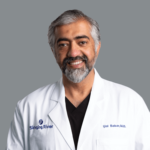Diagnosing Lung Cancer
We sat down with Dr. Ijlal Babar, a pulmonologist with Singing River Health System to discuss the innovative ways our medical experts are diagnosing lung cancer and helping to improve lung cancer survival rates.
How do we diagnose lung cancer?
“One of the techniques we use to diagnose lung cancer is the low dose CT scan, which is like a mammogram for breast cancer or the PSA for prostate cancer. These lung CTs are now catching cancer in it’s very early stages. After seeing the results of the CT scan, we have to be able to go and diagnose it. Bronchoscopy is one of the tools we use to diagnose it and basically, what it is, is a fiber optic scope which we use to go into the lungs and get these biopsies.”
What are the different bronchoscopy techniques?
“Within bronchoscopy there are additional techniques that we use, and some of these techniques are relatively new and we are some of the first people to introduce these to the Mississippi Gulf Coast. Some of these techniques really no one else is doing right now.
So one of the things I want to talk about is something called endobronchial ultrasound. We have an ultrasound tip on the bronchoscope that we can put against the walls of the trachea and the bronchi and we can actually see lymph nodes that could have cancer in them and sometimes lung cancer that is outside the walls of the bronchi and put a needle through the wall and then get a specimen. The endobronchial ultrasound is actually becoming really important for us to stage cancer because we can actually decide on how far advanced it is by sampling the lymph nodes.
The second technique that we use is something called navigational bronchoscopy and in navigational bronchoscopy what we have is almost like a GPS. This is for accessing small spots which are not within the airways themselves. Before this technique came up we really couldn’t get anything unless it was a really big three-centimeter lesion close to the center. Now we can get sub-centimeter lesions out in the periphery. It’s basically a software that leads us to it like a GPS, so the software basically guides our probe and gets us to the lesion and then we put a needle or another forceps in and get it. So we’ve been able to access lesions that you know, even five years ago, we couldn’t imagine getting to.”
Are these techniques improving lung cancer survival rates?
“So we know that low dose CT scans have improved survival rates and that is why for the first time in the history of lung cancer they’ve actually approved a screening tool. In the past all the studies, the data on chest X-rays, because that’s all they had, didn’t show any benefit in mortality, with the low dose CT there’s been a benefit in mortality.
Now does bronchoscopy have a benefit in mortality? We don’t know yet. We don’t have a study. All we know is that doing the low dose CT scan does.”
Does a patient need a referral for these procedures?
“Primary care physicians are more and more doing low dose CT scans and catching lesions. Once a legion is caught it’s usually sent over to us to decide and so we are the one to decide if bronchoscopy is probably the best technique to do it. Maybe a needle biopsy by the radiologist is a better technique to do it. We make that decision because we know which approach is going to work for the lungs. So almost anybody who identifies that, whether it’s the oncologist or a primary care doctor, he sends the patient to us and we take it from there.”
